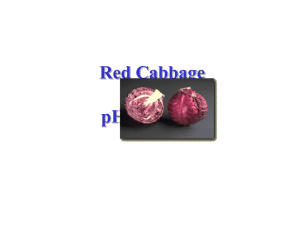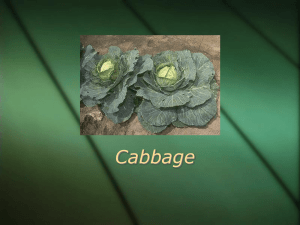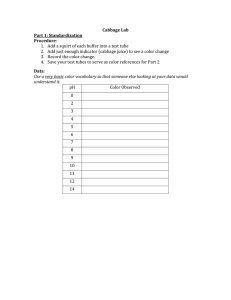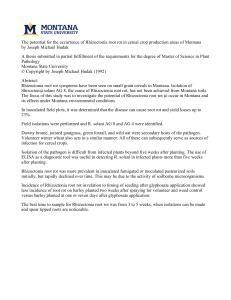EVALUATION OF BACTERICIDES AND PLANT DEFENSE ACTIVATORS FOR
advertisement
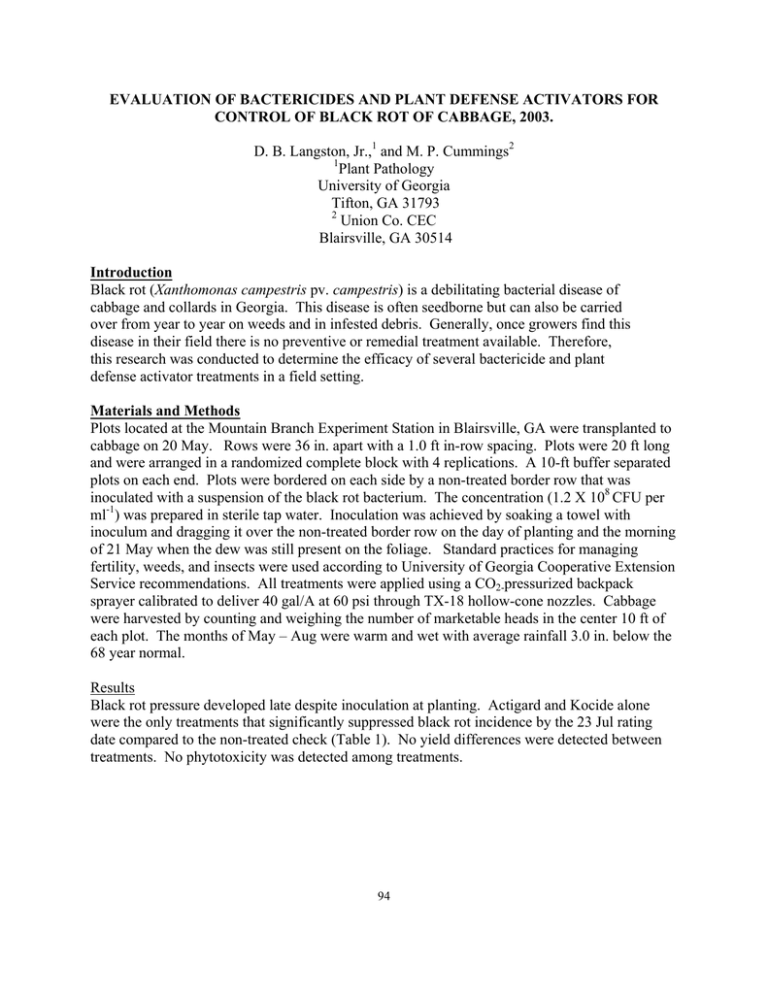
EVALUATION OF BACTERICIDES AND PLANT DEFENSE ACTIVATORS FOR CONTROL OF BLACK ROT OF CABBAGE, 2003. D. B. Langston, Jr.,1 and M. P. Cummings2 1 Plant Pathology University of Georgia Tifton, GA 31793 2 Union Co. CEC Blairsville, GA 30514 Introduction Black rot (Xanthomonas campestris pv. campestris) is a debilitating bacterial disease of cabbage and collards in Georgia. This disease is often seedborne but can also be carried over from year to year on weeds and in infested debris. Generally, once growers find this disease in their field there is no preventive or remedial treatment available. Therefore, this research was conducted to determine the efficacy of several bactericide and plant defense activator treatments in a field setting. Materials and Methods Plots located at the Mountain Branch Experiment Station in Blairsville, GA were transplanted to cabbage on 20 May. Rows were 36 in. apart with a 1.0 ft in-row spacing. Plots were 20 ft long and were arranged in a randomized complete block with 4 replications. A 10-ft buffer separated plots on each end. Plots were bordered on each side by a non-treated border row that was inoculated with a suspension of the black rot bacterium. The concentration (1.2 X 108 CFU per ml-1) was prepared in sterile tap water. Inoculation was achieved by soaking a towel with inoculum and dragging it over the non-treated border row on the day of planting and the morning of 21 May when the dew was still present on the foliage. Standard practices for managing fertility, weeds, and insects were used according to University of Georgia Cooperative Extension Service recommendations. All treatments were applied using a CO2-pressurized backpack sprayer calibrated to deliver 40 gal/A at 60 psi through TX-18 hollow-cone nozzles. Cabbage were harvested by counting and weighing the number of marketable heads in the center 10 ft of each plot. The months of May – Aug were warm and wet with average rainfall 3.0 in. below the 68 year normal. Results Black rot pressure developed late despite inoculation at planting. Actigard and Kocide alone were the only treatments that significantly suppressed black rot incidence by the 23 Jul rating date compared to the non-treated check (Table 1). No yield differences were detected between treatments. No phytotoxicity was detected among treatments. 94 Table 1. Effect of bacteria suppressive treatments on black rot severity & yield. BRy 23 Jul No.x Heads Totalw Yield Actigard 50WG, 0.75 oz (1, 3, 6) ...................................45.3 cv 7.5 a 37.2 a Oxidate, 1:100 (1-3), 1:300 (4-6) ..................................115.8 a 3.8 a 21.3 a Kocide 2000 DF, 1.5 lb (1-6)...........................................23.3 c 7.3 a 41.4 a Kocide 2000 DF, 1.5 lb + Maneb, 2.0 lb (1-6) ................53.8 bc 9.5 a 57.0 a z Treatment and rate/A Non-treated ......................................................................89.0 ab 5.5 a 36.1 a Spray dates are shown parenthetically and are as follows: 1=20 May; 2=30 May; 3=6 June; 4=27 Jun; 5=3 Jul; 6=11 Jul. y Ratings represent the number of lesions of Alternaria leaf spot (AS) and black rot (BR) per plot. x Data represents the total number of marketable cabbage heads per plot on 23 July. w Data represents the total weight in pounds of cabbage heads per plot on 23 July. v Means in columns with the same letter(s) are not significantly different according to Fisher’s Protected LSD test at P≤0.05. z 95

